[1]
D. Yuliono, "Kapasitas Adsorpsi Arang Aktif Batang Pisang (Musa paradisiaca) Terhadap Ion Logam Kromium VI," J. Chem., vol. 15, no. 2, p.24–32, 2014.
Google Scholar
[2]
D. Saputro, S., "Kajian Adsorpsi Ion Logam Cr VI (VI) oleh Adsorben Kombinasi Arang Aktif Sekam Padi dan Zeolit Menggunakan Metode Solid Phase Spectrophotometry," J. Sains Dasar, vol. 5, no. 2, p.116–123, 2016.
DOI: 10.21831/jsd.v5i2.13718
Google Scholar
[3]
W. T. Tan and A. r. M. Khan, "Removal of Lead, Cadmium and Zinc by Waste Tea Leaves," J. Environ. Technol., vol. 9, p.1223–1232, 1989.
Google Scholar
[4]
E. Munaf and R. Zein, "The use of rice husk for removal of toxic metals fromwastewater," J. Environ. Technol., vol. 18, p.359–362, 1997.
DOI: 10.1080/09593331808616549
Google Scholar
[5]
E. Munaf and R. Zein, "Pemanfaatan Sabut Kelapa Sawit untuk Menyerap Ion Logam Kadmium dan Kromium Dalam Air Limbah.," J. Kim. Andalas, vol. 5, no. 1, p.10–14, 1999.
Google Scholar
[6]
D. Mekonnen, E., "Kinetic and Thermodynamic Studis of the Adsorption of Cr VI (VI) onto Some Selected Local Adsorbents," J. Sabinet, vol. 68, p.45–52, 2015.
DOI: 10.17159/0379-4350/2015/v68a7
Google Scholar
[7]
D. Jorfi, S., "Adsorption of Cr VI (VI) by Natural Clinoptilolite Zeolite from Aqueous Solutions," Polish J. Chem. Technol., vol. 19, no. 5, p.106–115, 2017.
DOI: 10.1515/pjct-2017-0056
Google Scholar
[8]
D. Ekpete, O. A., "Adsorption of Chromium (VI) and Zinc (II) Ions ong. the Skin of Orange Peels (Citrus sinensis)," J. Nepal Chem. Soc, vol. 26, 2010.
DOI: 10.3126/jncs.v26i0.3628
Google Scholar
[9]
D. Shahi, M., "Removal of Hexavalent Chromium (VI) Using Activated Carbon Prepared from Mango Kernel Activated with H3PO4," Resour. Technol., vol. 2, no. 2016, pp. S63–S70, 2016.
DOI: 10.1016/j.reffit.2016.11.011
Google Scholar
[10]
M. A. Atieh, "Removal of Chromium (VI) from Polluted Water Using Carbon Nanotubes Supported with Activated Carbon," Procedia Environ. Sci., vol. 4, no. 1, p.281–293, 2011.
DOI: 10.1016/j.proenv.2011.03.033
Google Scholar
[11]
D. Pang, M., "Adsorption of Chromium (VI) from Aqueous Solution Using Zeolite/Chitosan Hybrid Composite," J. Chem. Chem. Eng, vol. 9, p.433–441, 2015.
Google Scholar
[12]
F. Gorzin and A. M, "Adsorption od Cr VI (VI) from Aqueous Solution by Adsorbent Prepared from Paper Mill Sludge: Kinetics and Thermodynamics Studies," Adsorpt. Sci. Technol., vol. 36, no. 1, p.149–169, 2018.
DOI: 10.1177/0263617416686976
Google Scholar
[13]
D. Owalude, S., "Removal of Hexavalent Chromium from Aqueous Solutions by Adsorption on Modified Goundnutt hull," Beni-Suef Univ. J. Basic Appl. Sci., vol. 9, p.433–441, 2015.
DOI: 10.1016/j.bjbas.2016.11.005
Google Scholar
[14]
D. Rani, N., "Chromium (VI) Removal from Aqueous Soluations Using Eichhornian as an adsorbent," J. Water Reuse Desalin., vol. 7, no. 4, p.461–467, 2017.
DOI: 10.2166/wrd.2016.094
Google Scholar
[15]
D. Derdeour, K., "Removal of Cr VI (VI) for Aqueous Solutions by Using Activated Carbon Supported Iron Catalyst as Efficient Adsorbent," World J. Eng., vol. 15, no. 1, p.3–13, 2019.
Google Scholar
[16]
C. Dragan, "Removal of Cr VI (VI) from Aqueous Solution Using Activated Charcoal," Int. J. Chem. Chem. Eng. Syst., vol. 3, p.11–15, 2018.
Google Scholar
[17]
E. C. Ijeamaka, "Isoterm Studies of Adsorption of Cr VI (VI) Ions onto Coconut Husk," Int. J. Biochem. Biophys. Mol. Biol., vol. 3, no. 2, p.38–44, 2018.
DOI: 10.11648/j.ijbbmb.20180302.13
Google Scholar
[18]
D. Gayathri, "A Study on Adsorption of Chromium (VI) ions from Aquose Solution by Ficus Religiosa Leaves as Adsorbent," Pelagia Res. Libr., vol. 4, no. 3, p.79–87, 2013.
Google Scholar
[19]
N. Patri, "Adsorpsi ion Cr(III) danCr(VI) Menggunakan Bentonit Termodifikasi Oksida Besi," ITB, 2012.
Google Scholar
[20]
D. Balarak, "Removal of Hexavalent Chromium from Aquose Solution using Cannola Biomass: Isoterm and Kinetic Studies," J. Adv. Enviromental Heal. Res., vol. 2, no. 4, p.235–241, 2014.
Google Scholar
[21]
K. Muthukumaran and S. Beulah, "Removal of Chromium (VI) from Wastewater Using Chemically Activated Syzygium Jambolanum Nut Carbon by Batch Studies," Sience Direct, vol. 4, p.266–280, 2010.
DOI: 10.1016/j.proenv.2011.03.032
Google Scholar
[22]
D. Dula, T., "Adsorption of Hexavalent Chromium from Aqueous Solution Using Chemicallu Activated Carbon Prepared from Locally Available Waste of Bamboo," Res. Artic., vol. 14, no. 9, p.2–10, 2014.
DOI: 10.1155/2014/438245
Google Scholar
[23]
D. Figueiredo, H., "The Role oh pH on Cr VI (VI) Reduction and Removal by Arthrobacter Viscosus," Int. J. Chem. Biol. Eng., vol. 2, no. 2, p.100–103, 2009.
Google Scholar
[24]
R.D. Martin, "Kinetic Study of Absorption of Chromium (VI) Using Canary Bananas Peels in Contamined Water," Int. J. Innov. Sci. Res., vol. 22, no. 1, p.139–145, 2016.
Google Scholar
[25]
D. Darjito., Purwonugroho, and R. Ningsih, "The Adsorption of Cr (VI) Ions Using Chitosan-Alumina Adsorbent," J. Pure Appl. Chem. Res., vol. 3, no. 2, p.53–61, 2014.
DOI: 10.21776/ub.jpacr.2014.003.02.139
Google Scholar
[26]
M.A. Hossain, H.H. Ngo, W.S. Guo, and T.V. Nguyen, "Removal of Copper from Water by Adsorption onto Banana Peel as Bioadsorbent," Int. J. Geomate, EOMATE, vol. 2, no. 2, p.227–234, 2012.
DOI: 10.21660/2012.4.3c
Google Scholar
[27]
I.V Wijayanti and E.A. Kurniawati, "No Title," Stud. Kinet. Adsorpsi Isoterm Persamaan Langmuir Dan Freundl. Pada Abu Gosok Sebagai Adsorben, vol. 4, no. 2, p.175–184, 2019.
DOI: 10.30870/educhemia.v4i2.6119
Google Scholar


